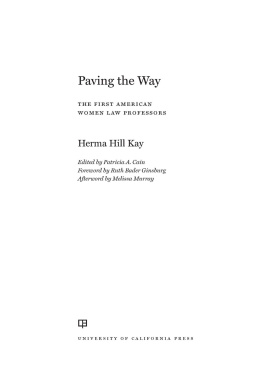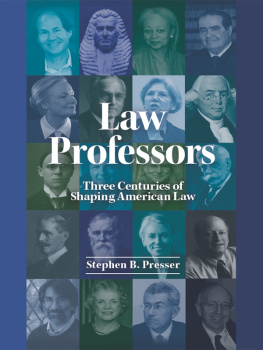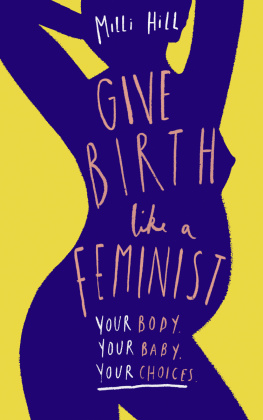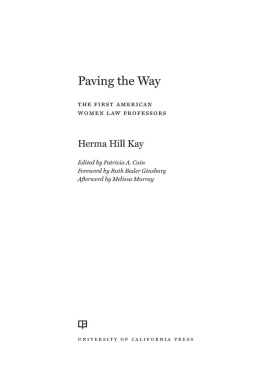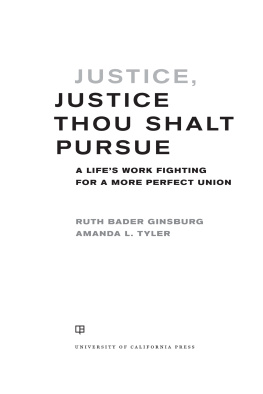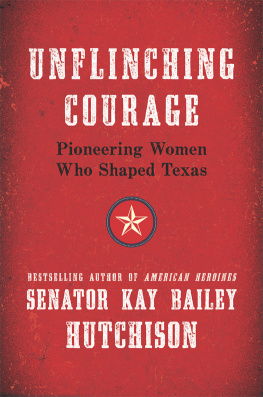Born under a lucky star, I had the good fortune to experience Herma Hill Kays brilliant teaching, to rely on her as mentor and role model, to work with her in countless meetings of the American Law Institute, and to enjoy her loyal friendship. She spoke passionately about the project that became this remarkable book. Hermas decades-long efforts to document and share these trailblazers stories give us one more reason to celebrate her own commitment to changing the world for lawyers of all genders.
Susan Frelich Appleton, Washington University School of Law in St. Louis
No one else has written about the first women law professors in the U.S. The fact that the author was the fifteenth, and the fact that she was able to interview nine of these women, makes this work so valuable. I think it is crucial for women law professors to know about our foremothers and their contributions to the profession and to law in general.
Paving the Way: The First American Women Law Professors, by Herma Hill Kay; edited by Patricia A. Cain
Justice, Justice Thou Shalt Pursue: A Lifes Work Fighting for a More Perfect Union, by Ruth Bader Ginsburg and Amanda L. Tyler
Paving the Way
THE FIRST AMERICAN WOMEN LAW PROFESSORS
Herma Hill Kay
Edited by Patricia A. Cain
Foreword by Ruth Bader Ginsburg
Afterword by Melissa Murray

UNIVERSITY OF CALIFORNIA PRESS
University of California Press
Oakland, California
2021 by Herma Hill Kay Living Trust
Library of Congress Cataloging-in-Publication Data
Names: Kay, Herma Hill, author. | Cain, Patricia A., editor. | Ginsburg, Ruth Bader, writer of foreword. | Murray, Melissa, writer of afterword.
Title: Paving the way : the first American women law professors / Herma Hill Kay, edited by Patricia A. Cain ; foreword by Ruth Bader Ginsburg; afterword by Melissa Murray.
Description: Oakland, California : University of California Press, [2021] | Includes bibliographical references.
Identifiers: LCCN 2020047071 (print) | LCCN 2020047072 (ebook) | ISBN 9780520378957 (cloth) | ISBN 9780520976467 (ebook)
Subjects: LCSH : Women law teachersUnited StatesBiography.
Classification: LCC KF 372 . K 39 2021 (print) | LCC KF 372 (ebook) | DDC 340.092/520973dc23
LC record available at https://lccn.loc.gov/2020047071
LC ebook record available at https://lccn.loc.gov/2020047072
Manufactured in the United States of America
25 24 23 22 21
10 9 8 7 6 5 4 3 2 1
Contents
Foreword
Herma Hill Kay, author of this volume, was the fifteenth woman to hold a tenure-track position at a law school accredited by the Association of American Law Schools (AALS). For more than twenty-five years, she has devoted her time and talent to bringing vividly to life the work and days of the fourteen women who preceded her in appointments to AALS-accredited law faculties. And in a final chapter, she tells of the women who came next, achieving tenure-track appointments in the half-century and more since 1960. Retrieving this history was a huge undertaking, one of inestimable value. To tell the stories of the first fourteen, Kay read their publications, personally interviewed the nine still alive when she embarked on the project, and elicited the remembrances of both colleagues and scores of students. Without Kays prodigious effort, we could not adequately comprehend how women altered legal education and law itself.
Most of the pioneersthe seven appointed from 1919 to 1949, and the equal number appointed in the next decadedid not think of themselves as exceptional or courageous. Eleven were married, nine had children. Several were family law scholars and reformers, but most taught in diverse areas, including commercial law, corporate law, and oil and gas law. As one of them commented: We didnt talk about what we were doing. We just did it. Different as they were, they shared a quality essential to their success: perseverance. And all of them overcame the odds against them for the same reason: they found law study and teaching fulfilling.
Figure 1. Justice Ruth Bader Ginsburg and Professor Herma Hill Kay together following Kays recognition with the American Association of Law Schools Ruth Bader Ginsburg Lifetime Achievement Award, 2015. Courtesy of Amanda Tyler.
Reading the manuscript, I found one thing missing; Kay tells us almost nothing about herself. It is fitting, I decided, to address that omission in this introduction by writing of Herma Hill Kay, law teacher, scholar, and reformer nonpareil. She is my treasured friend, so I will refer to her by her first name.
On Professor Curries recommendation, Herma gained a 1959 clerkship with California Supreme Court Justice, and later, Chief Justice, Roger J. Traynor, a jurist known for his brilliance and his humanity. Despite Traynors strong endorsement of Herma, Chief Justice of the United States Earl Warren wasnt up to engaging a woman as his law clerk in 1960, nor were his fellow Justices.
Traynors recommendation carried heavier weight with the Berkeley law faculty, where Herma commenced her career in the academy, and in just three years, became a full professor with tenure in 1963. Inspired and encouraged by Berkeleys distinguished Professor Barbara Armstrong, first woman to achieve tenure on any United States law faculty, Herma made family law her field of concentration, along with Conflict of Laws.
At a young age uncommon for such assignments, in 1968 Herma was appointed Co-Reporter of the Uniform Marriage and Divorce Act. That endeavor of the National Conference on Uniform State Laws launched no-fault divorce as an innovation that would sweep the country in a decades span. In the ensuing years, in California and elsewhere, Herma strove to make marriage and divorce safer for women.
Herma and I first met at a Women and the Law Conference in 1971. For the rest of that decade, she was my best and dearest working colleague. Together with Kenneth Davidson, we produced, in 1974, the first published set of course materials on sex discrimination and the law.
Before our first conversation, I knew Herma through her writings. She co-authored, with Roger Cramton and David Currie, the casebook I used in teaching Conflict of Laws.visiting offers. I was also aware of Hermas reputation as a woman of style, who had a private pilots license, flew a Piper Cub weekly, and navigated San Francisco hills in a sleek yellow Jaguar. In person, I quickly comprehended that Herma had a quality that cannot be conveyed in words. There was a certain chemistry involved when one met her, something that magically made you want to be on her side.
Hermas skill in the art of gentle persuasion accounts, in significant part, for the prominent posts she held in legal and academic circles. In 1973 and 1974, she chaired Berkeleys Academic Senate. She was, from 19922000, Berkeley Law Schools valiant Dean, meeting budgetary restrictions by honing her skills as a fundraiser, planning for the Law Schools new home, promoting depth and diversity in faculty appointments, and making the place more user-conscious and user-friendly. An unflinching partisan of equal opportunity and affirmative action, Herma managed to reset Berkeley Law Schools course to advance the admission of African American and Hispanic students after the initial shock of Proposition 209, Californias strident anti-affirmative action measure. Before and after her Deanship, she served the University and the Universitys Senate in various capacities, sitting on or chairing, by her own reckoning, fifty zillion committees.

